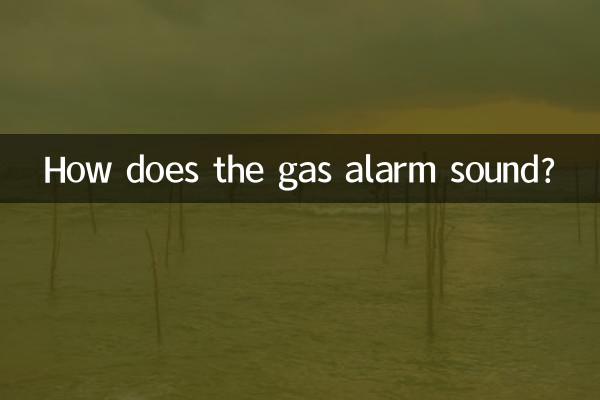How does the gas alarm sound? Comprehensive analysis of alarm signals and countermeasures
Recently, the issue of gas safety has once again become a hot topic on the Internet. According to incomplete statistics, in the past 10 days, the number of discussions about gas leak accidents on social platforms and news websites has increased by 35% month-on-month. Fire departments in many places have also issued reminders emphasizing the importance of installing gas alarms. This article will provide a detailed explanation of the alarm signals, working principles and emergency response of gas alarms, and attach data on recent hot gas safety incidents.
1. Alarm signal types of gas alarms

Different brands of gas alarms may use different alarm methods, but they mainly include the following three signal modes:
| Alarm type | sound characteristics | Light reminder | Applicable scenarios |
|---|---|---|---|
| General alarm | Continuous beeping sound (above 85 decibels) | Flashing red | Gas leak detected |
| Fault alarm | Intermittent "beep" sound (once every 30 seconds) | Yellow always on | Sensor failure or insufficient battery |
| Self-test tips | Short "beep" sound (1 time at startup) | flashing green | Equipment power-on self-test |
2. Recent hot gas safety events (last 10 days)
| date | area | Event Summary | Alarm function |
|---|---|---|---|
| 2023-11-15 | Chaoyang District, Beijing | Gas pipeline leakage in old residential area | Alarms provide early warning to avoid explosions |
| 2023-11-18 | Tianhe District, Guangzhou City | Restaurant gas valve is not closed | Linkage cutting device starts |
| 2023-11-20 | Wuhou District, Chengdu City | Gas accumulation caused by residents' misuse | Smart alarm pushes mobile phone reminder |
3. Working principle of gas alarm
When the gas concentration in the environment exceeds the set threshold (usually 5% LEL for natural gas and 10% LEL for liquefied gas), the alarm will sound an alarm through the following mechanism:
1.Sensor detection: Semiconductor/catalytic combustion sensor monitors gas concentration in real time
2.signal conversion: Convert chemical signals into electrical signals
3.Alarm trigger: The processor determines that the concentration exceeds the standard and starts an audible and visual alarm.
4.Linkage device(Optional): Advanced models can automatically close the solenoid valve or activate the exhaust fan
4. Countermeasures for different alarm sounds
| Alarm status | Correct handling steps | Prohibited behavior |
|---|---|---|
| continuous sharp alarm | 1. Open windows immediately for ventilation 2. Close the main gas valve 3. Evacuate the scene and call the police | Switching electrical appliances/using open flames |
| intermittent alarm | 1. Check the device battery level 2. Clean the sensor 3. Contact after-sales maintenance | Forcibly dismantle equipment |
5. Consumer Buying Guide
According to the latest sampling inspection data from the State Administration for Market Regulation, qualified gas alarms should have the following characteristics:
1. Marked with "GB15322-2019" national compulsory certification
2. Clearly mark the detection gas type (natural gas/liquefied gas/carbon monoxide)
3. With regular self-check function
4. Alarm volume ≥85 decibels (can be heard clearly within 3 meters)
6. Special reminder from experts
The guide recently released by the China City Gas Association emphasizes:
• The alarm should be installed 1-4 meters away from the gas appliance and within 30cm from the ceiling.
• The alarm function needs to be tested monthly (press the test button for 3 seconds)
• The service life is usually 3-5 years and must be replaced when it expires
• Increase the frequency of inspections during the winter heating period
Many recent cases have proven that correctly used gas alarms can reduce the risk of gas accidents by more than 90%. It is recommended that residents not only understand the meaning of the alarm sound, but also establish a conditioned reflex of "hear the alarm - act immediately" to jointly protect family safety.

check the details

check the details